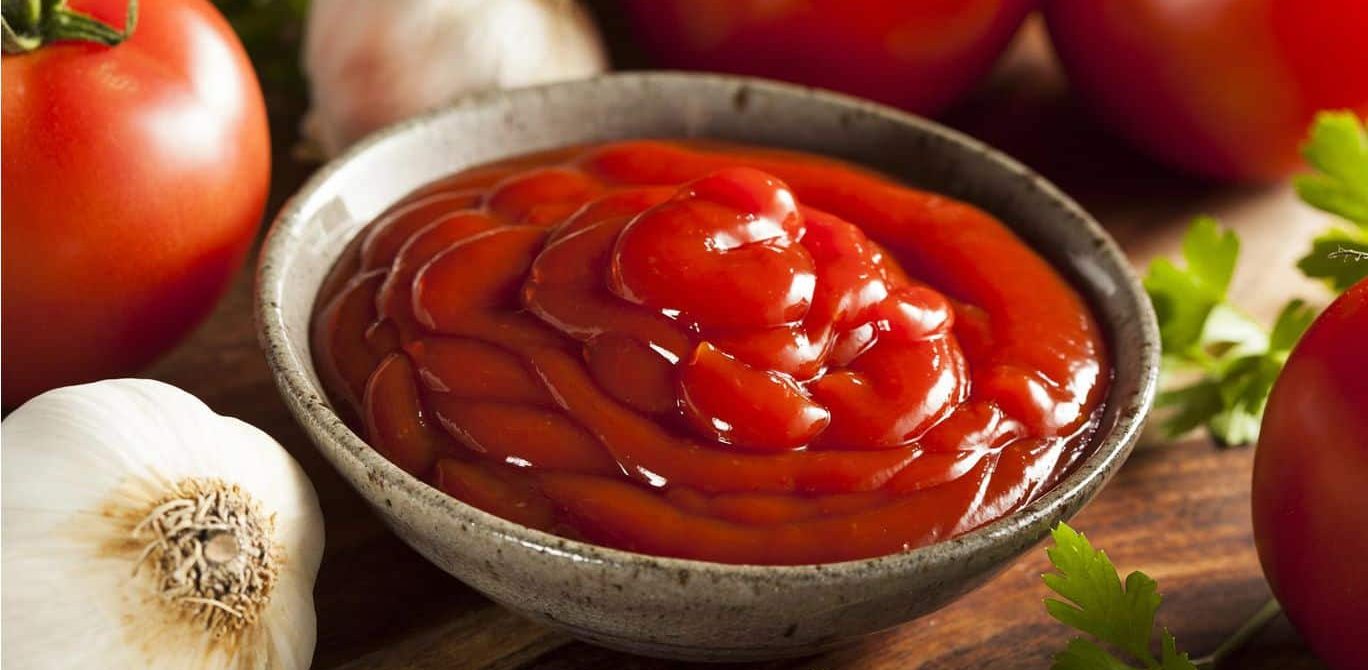Tomato ketchup is a type of condiment that is created by combining tomato paste that has been condensed with water, sugar, vinegar, salt, and other flavors. The "Hot Break" method is generally used during the manufacturing process of the tomato paste. Tomato pulp is brought to a temperature of 200 degrees Fahrenheit (90 degrees Celsius) using this technique. The pectin that is naturally present in tomatoes is maintained by doing this; however, some of the flavor and color is lost in the process. The viscosity of premium quality ketchup with a high solids content comes from a combination of water retention by the fibrous strands in the paste and the gelling effect of the pectin, which is released via high-pressure homogenization. Both of these factors contribute to the ketchup's thick consistency.  Ketchup with a lower percentage of solids could also have gums or thickeners that are based on starch. There is a wide range of variety in the formulation, viscosity, and amount of solids contained in ketchup. Tomato paste is often mixed with water and the other ingredients, and the manufacturing process continues in one of two ways, depending on which option is chosen: When using the pectin that is already present in the paste as a thickening agent, the fibrous strands that are found in the tomatoes need to be fibrillated (frayed) in order to improve their capacity for water retention, which in turn raises their viscosity. After being thoroughly combined, the product is sent through a high-pressure homogenizer in order to achieve the desired degree of smoothness. This approach can also be used to boost yield, as it is possible to generate a thicker product with a smaller total amount of solids utilized in the process. With the second technique of processing, high-pressure homogenization is not used. Instead, thickening agents such as xanthan gum, pectin, or starch (including modified starches) are utilized to achieve the appropriate level of viscosity in the finished ketchup product. In order to produce a finished good that is free of agglomerates, the mixing apparatus that is used for either approach must be capable of dispersing powdered components into water. When employing conventional agitators, you run the risk of encountering a number of difficulties, including the following: Because liquids with drastically different viscosities are difficult for agitators to combine, the process of diluting tomato paste with water requires a significant amount of time spent mixing. Additives that are meant to make the product thicker have a tendency to produce agglomerates, which agitators have a difficult time breaking down. It is possible for partially hydrated components to accumulate on the wall of the vessel and on various elements of the mixer. Extended periods of mixing are necessary in order to completely disperse the ingredients. The homogenizer calls for a pre-mix that is completely homogenous. Using agitators to achieve this result is not a simple task. Homogenization and other forms of processing can leave ketchup with an unpleasant finish.
Ketchup with a lower percentage of solids could also have gums or thickeners that are based on starch. There is a wide range of variety in the formulation, viscosity, and amount of solids contained in ketchup. Tomato paste is often mixed with water and the other ingredients, and the manufacturing process continues in one of two ways, depending on which option is chosen: When using the pectin that is already present in the paste as a thickening agent, the fibrous strands that are found in the tomatoes need to be fibrillated (frayed) in order to improve their capacity for water retention, which in turn raises their viscosity. After being thoroughly combined, the product is sent through a high-pressure homogenizer in order to achieve the desired degree of smoothness. This approach can also be used to boost yield, as it is possible to generate a thicker product with a smaller total amount of solids utilized in the process. With the second technique of processing, high-pressure homogenization is not used. Instead, thickening agents such as xanthan gum, pectin, or starch (including modified starches) are utilized to achieve the appropriate level of viscosity in the finished ketchup product. In order to produce a finished good that is free of agglomerates, the mixing apparatus that is used for either approach must be capable of dispersing powdered components into water. When employing conventional agitators, you run the risk of encountering a number of difficulties, including the following: Because liquids with drastically different viscosities are difficult for agitators to combine, the process of diluting tomato paste with water requires a significant amount of time spent mixing. Additives that are meant to make the product thicker have a tendency to produce agglomerates, which agitators have a difficult time breaking down. It is possible for partially hydrated components to accumulate on the wall of the vessel and on various elements of the mixer. Extended periods of mixing are necessary in order to completely disperse the ingredients. The homogenizer calls for a pre-mix that is completely homogenous. Using agitators to achieve this result is not a simple task. Homogenization and other forms of processing can leave ketchup with an unpleasant finish. 
Commercial tomato paste
Both the summer and winter seasons in our country are ideal for growing tomatoes, and producing tomato paste which results in a plentiful harvest year-round. The crop that is grown during the winter months has a higher quality overall because it has a higher total solids content. The flavor, sweetness, and nutritional value that are present in the fresh fruits are all preserved in the commercial tomato paste. The tomato processing industry in India is comprised of businesses that utilize cutting-edge production facilities and cutting-edge technologies. Roughly eighty percent of tomatoes are consumed in their fresh form, and the remaining twenty percent are used in the processing industry to create tomato paste, puree, ketchup, pickles, juices, and sauces. The processing of fresh and ripened tomatoes results in the production of a smooth and thick substance known as tomato paste. Raw materials used in the production of tomato-based processed goods often include tomato paste. The industry that uses the most tomato paste is the one that makes condiments like ketchup and sauces. More than one thousand five hundred different kinds of tomatoes are grown commercially in India. Only a select few cultivars are grown for commercial purposes. With an annual output of 20 million tomatoes, India is the world's second-largest producer of tomatoes after China. India is responsible for 11% of the total production of tomatoes around the globe. On the other hand, India barely processes 150000 tonnes of tomatoes every year. The number of tomato-based processed goods that are in demand in India has increased by forty percent. It is estimated that 150000 tonnes of ketchup are used annually in India, and that this results in a market value of 1. 8 billion. Even though tomato paste is produced in a great number of nations, the top ten producers are responsible for 83 percent of the annual production around the globe. The United States, India, and Turkey are the next three major producers of tomatoes after China, which is the world's largest producer of tomatoes. In addition, the tomato is grown in the hemisphere of the Northern Hemisphere, where it is processed in the months of July and December. Production in the southern hemisphere region occurs between the months of January and June. Brazil is the only nation in the Southern hemisphere capable of processing one million tons per year during the same season as the country's counterparts in the Northern hemisphere. 
Production of tomato paste
Processing of tomatoes industrial sector: production capacities of paste In contrast to guava and mango, there are not as many industries that process tomatoes as there are those that process mango and guava. The districts of Krishnagiri and Chittoor in India are home to the majority of the country's processing industry. Only a small number of the types that are grown in India are utilized for processing, whereas the majority of the varieties grown there are used for consumption. The major producing and trading nations exported 6. 8 million tonnes of tomato paste in 2019-20, which is a 35% increase compared to the previous year's total. The international commerce in tomato products brought in a total of USD 6. 4 billion in revenue last year, with the export market for tomato paste accounting for USD 3. 1 billion of that total. The demand for tomato paste has been rising at a consistent rate, and China has committed substantial capital investment to overtake the United States of America and Italy as the industry leaders. The southern areas of India are home to the majority of the manufacturing industries that process tomatoes. Because of their close vicinity to tomato growing areas, tomato processing factories in South India are able to successfully produce tomato paste.  This proximity allows for this type of manufacturing to be economically viable. According to an estimate provided by the World Processing Tomato council, 41. 37 million metric tons of tomatoes were transformed into products with additional value all over the world. As a result, constitute 26% of the whole production of fresh tomatoes. In comparison, just around 1% of tomatoes produced are processed in any way that results in value addition to the final product.
This proximity allows for this type of manufacturing to be economically viable. According to an estimate provided by the World Processing Tomato council, 41. 37 million metric tons of tomatoes were transformed into products with additional value all over the world. As a result, constitute 26% of the whole production of fresh tomatoes. In comparison, just around 1% of tomatoes produced are processed in any way that results in value addition to the final product.
